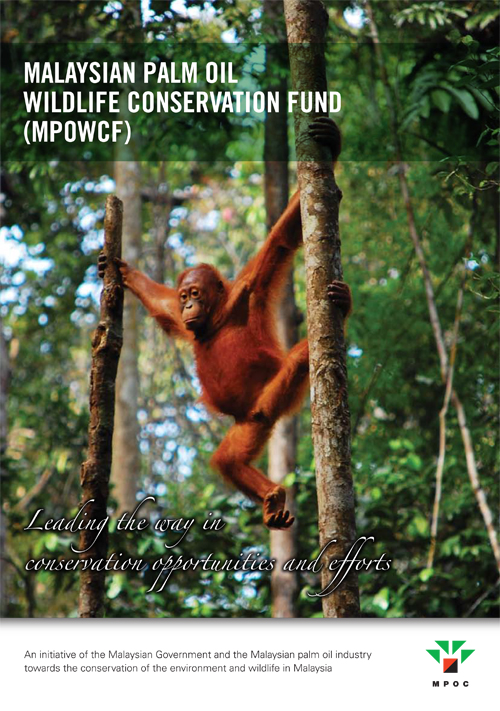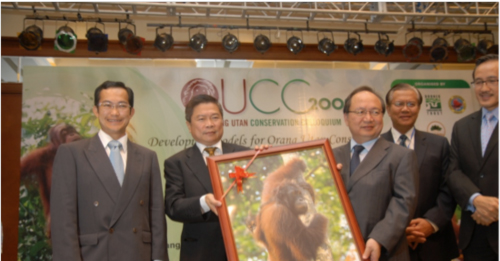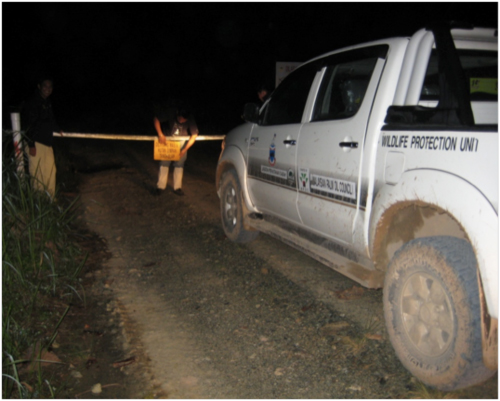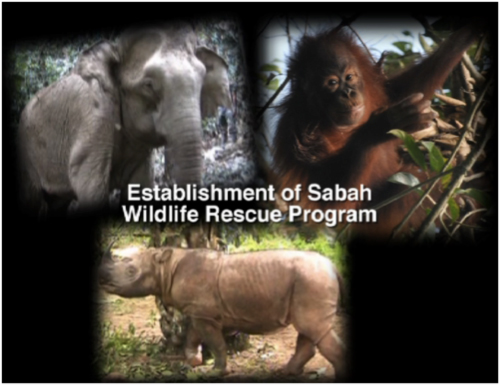Malaysian Palm Oil Wildlife Conservation Fund (MPOWCF)
The palm oil industry adopts and implements sustainable and good agricultural practices, yet is has been accused of unsustainable practices including the destruction of rainforests and wildlife habitat, particularly the orang utan. These accusations driven by campaigns, primarily led by the European NGOs have resulted in misunderstanding among some traditional palm oil end users who have in turn taken drastic steps to reduce their palm oil usage in consumer products. The negative publicity perpetrated by the NGOs sometimes has led to calls to boycott palm based products in several European countries. These negative campaigns have similarly dented the use of palm oil as a renewable fuel requiring the need to prove that it is sustainably produced.
The Malaysian palm oil industry, backed by more than 90 years of responsible plantation practices on legally approved agricultural land in accord with legislations in the country, has similarly not been spared these accusations, despite numerous efforts to portray the correct efforts and information. The idea for the setting up of the Malaysian Palm Oil Wildlife Conservation Fund (MPOWCF) was therefore mooted by the Malaysian Palm Oil Council (MPOC) in 2006 coinciding with the period when the Malaysian palm oil industry was facing one of its biggest challenges in the form of these negative campaigns.

MPOWCF was thus launched with an initial funding of RM20 million of which RM10 million is a grant from the Malaysian government and the balance of RM10 million is provided by the palm oil industry. The fund is administered by the Malaysian Palm Oil Council (MPOC), which also has the overall responsibility to manage the various conservation projects funded through MPOWCF.
The MPOWCF serves the following purposes:
- Helps to portray the good image of Malaysian palm oil by providing concrete assurances that its cultivation does not cause deforestation or loss of wildlife and their habitat through a focused conservation research program to be undertaken by experts from the academia, government agencies and NGOs.
- Provides funds for studies on wildlife, biodiversity and environmental conservation while factoring the overall impact of the palm oil industry on these parameters.
Malaysian Government and Malaysian Palm Oil Industry’s Contribution to Biodiversity Conservation
Agriculture is a mainstay of the Malaysian economy. Malaysia, lying within the tropics, is blessed with copious rainfall and long sunshine hours, creating ambient conditions for the cultivation of many tropical crops. The British, when they colonized the country, had good acumen to use these bountiful resources by encouraging the cultivation of economic crops such as coffee, rubber, coconuts during the early part of the 20th century. Some forests had to be cleared to plant these crops and, in the process, flora and fauna in the affected areas were lost. The displaced animals had to forage for food, killed domesticated animals in the nearby villages in the process, destroyed crops and even attacked and killed human beings. Such occurrences aroused fear in the people who lived and worked in these areas and led to a confrontation between wildlife and mankind, as human beings killed the wild animals in order to safeguard their lives and their livelihood. In addition, further loss of fauna biodiversity resulted from the actions of some of the indigenous people, who hunted wild animals for food.
Although oil palm was grown as early as 1917 in Malaysia, cultivation escalated only in the 1970s and onwards. Initially, much oil palm cultivated relied on land converted from other crops such as rubber and cocoa. Latter expansion depended on the use of logged over forest areas which had been scoured of its timber. Again, more flora and fauna were lost, leading to a decimation of their population. In this latter stage of development, fragmented forest landscape added further to the loss of wildlife.
The conscientious efforts of the Malaysian Wildlife Department and NGOs who carried out numerous studies showed that the population of some precious flora and fauna were diminishing. If left unabated, some species may even become extinct in the near future. This awareness led the Malaysian palm oil industry, which has always been a responsible industry, to take action by setting up the Malaysian Palm Oil Wildlife Conservation Fund (MPOWCF).
MPOWCF was launched in 2006 with an initial funding of Ringgit Malaysia (RM) 20 million of which RM10 million is a grant from the Malaysian government and the balance of RM10 million is provided by the palm oil industry. The Fund is administered by the Malaysian Palm Oil Council (MPOC), which has the overall responsibility to manage the various conservation projects funded through MPOWCF. Funds are provided for execution of projects and studies on wildlife, biodiversity and environmental conservation while factoring the overall impact of the palm oil industry on these parameters.
The MPOWC also accepts contributions from independent donors. For every ringgit contributed by an independent donor, MPOC will top it up with another ringgit, that is, on 1:1 basis. Details of MPOWCF can be found on MPOC’s website.
Since its inception, the following projects have been executed.
| No. | Project | Partner | Purpose | Status |
| 1 | Jungle Patrol Unit | Sabah Forestry Department | Safeguard wildlife and deter poaching | 2007- ongoing |
| 2 | Tabin Wildlife Reserve | Tabin Wildlife Sanctuary/Sabah Forestry Dept | Book “Tabin-Sabah’s greatest wildlife sanctuary” | 2007-2009 |
| 3 | Diversity of Ground Vegetation | Sabah Forestry Dept | Study in oil palm plantation | 2007 |
| 4 | Biodiversity conservation on ox-bow lake study | Universiti Malaysia Sabah | Inventory and environmental asssessments | 2007 |
| 5 | Orang Utan Island | MK Land | • Orang Utan Infant care • Orang Utan awareness programme for school children | 2007-2009 |
| 6 | Orang Utan Survey | Borneo Conservation Trust (BCT), Sabah Wildlife Department (SWD) & HUTAN (NGO) | Assess population & recommend solutions to increase population of orang utan | 2008 |
| 7 | Orang Utan Conservation Colloquium (OUCC 2009) | BCT, SWD, HUTAN | • Discuss current status of orang utan within oil palm landscapes • Discuss models for orang utan conservation | 2009 |
| 8 | Biodiversity for Plantation Managers | Wild Asia | Awareness on biodiversity and wildlife conservation | 2010 |
| 9 | Wildlife Rescue Centre | Sabah Wildlife Dept/ShangriLa Rasa Ria | Rescue & translocation of endangered wildlife found in oil palm landscapes | 2010-ongoing |
| 10 | Sabah Wildlife Conservation Colloquium 2012 | Sabah Wildlife Department | Shared/highlighted conservation efforts and studies, with a focus on endangered species in Borneo, Malaysia. | 2012 |
I very much appreciate your efforts to maintain the sustainability and wildlife protection for the Malaysian palm oil industry. Are donations to your organization tax-deductable? Posted by: Stephen Cherniske | 17 October 2015 12:34:11 PM.






